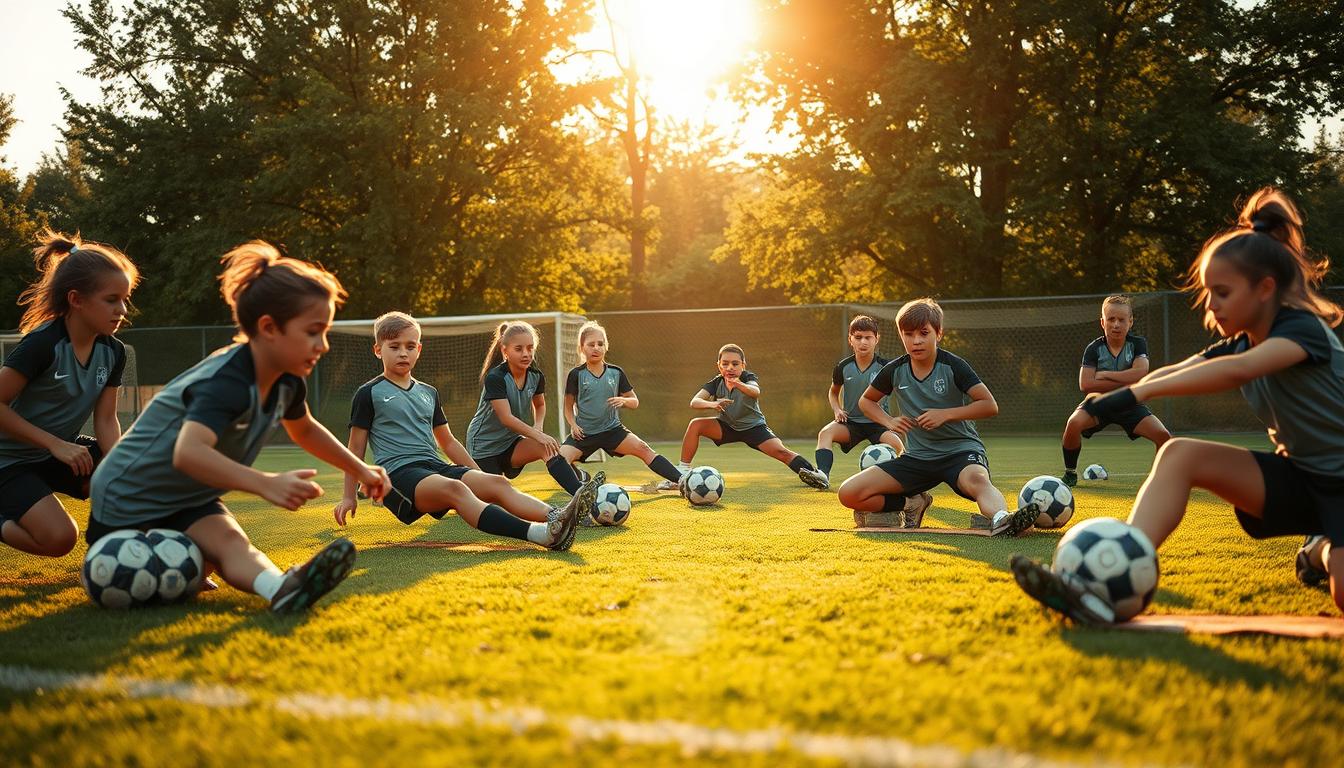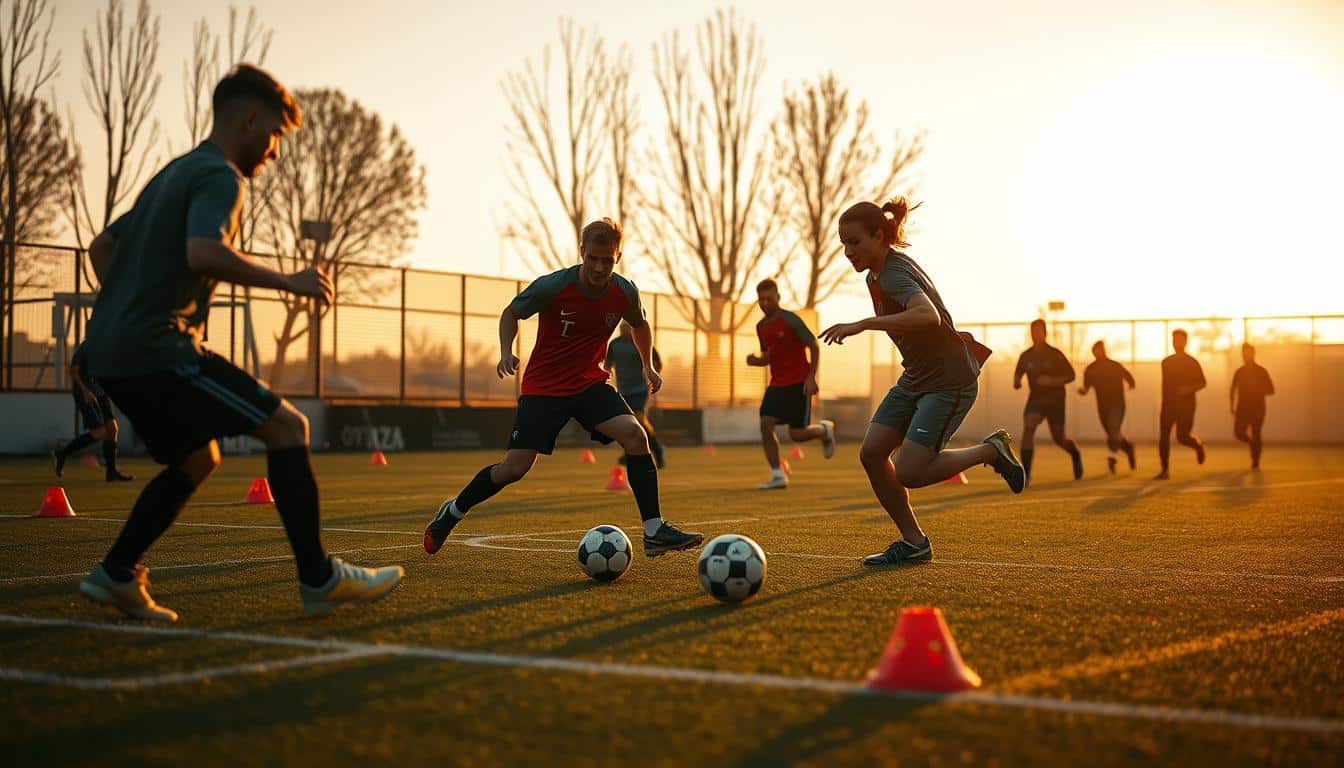Recovery Training Plans for Kids Soccer

If your young athlete is pushing hard on the field, balancing effort with smart recovery strategies makes all the difference. Without proper rest, even the most talented players risk burnout, injuries, or sluggish performance during critical games. The good news? A structured approach helps them bounce back faster—and play better.
Youth sports demand more than just drills and conditioning. Think of recovery as the secret weapon: it rebuilds muscles, sharpens focus, and keeps energy levels steady. For example, light movement on rest days improves circulation, while hydration and sleep fuel growth. Coaches and parents often overlook these steps, but they’re what separate good athletes from great ones.
This guide breaks down simple, effective methods to help players stay strong all season. You’ll learn how to blend active rest with strength-building routines—no gym required. Let’s turn downtime into progress.
Key Takeaways
- Recovery plans prevent fatigue and help young athletes perform consistently.
- Active rest (like walking or stretching) speeds up muscle repair.
- Proper hydration and nutrition boost energy for practices and games.
- Sleep is critical for physical growth and mental sharpness.
- Balancing drills with rest reduces injury risks during the season.
Understanding the Role of Recovery in Youth Soccer
Young athletes thrive when their bodies get the care they need between matches. Recovery isn’t just about sitting still—it’s a mix of light movement, proper nutrition, and rest. This process helps muscles rebuild, keeps energy high, and sharpens focus for the next game.
Benefits of Regular Recovery
Active breaks like walking or dynamic stretches boost blood flow, which speeds up muscle repair. Studies show players who take 48-72 hours between intense sessions perform better and stay injury-free. For example, a light jog or agility drills on rest days maintain flexibility without overworking the body.
| Benefit | Impact | Example |
|---|---|---|
| Faster Muscle Repair | Reduces soreness | Foam rolling after matches |
| Improved Focus | Better decision-making | Yoga for mental clarity |
| Lower Injury Risk | Stronger joints | Balance exercises |
Key Recovery Challenges
Busy school schedules and back-to-back practices make it tough to prioritize rest. Many players skip sleep or hydration, slowing their progress. Coaches recommend scheduling recovery windows as strictly as training—even 20-minute mobility routines count.
Soccer recovery training plans
Creating effective routines starts with understanding what each athlete uniquely requires. Watch for signs like slower sprint times or reduced ball control during drills—these hint at fatigue. A quick 1-10 scale helps gauge muscle soreness: anything above six means it’s time to adjust intensity.
Assessing Your Player’s Needs
Track performance weekly using simple tools. For example:
- Time agility drills to spot declines in speed
- Note hydration habits during practice sessions
- Observe posture after strength exercises
Light movement tests—like 10 bodyweight squats—reveal stiffness. Pair this with sleep logs to connect rest quality with on-field energy levels.
Setting Clear Recovery Goals
Focus on measurable targets that fit busy schedules. Try these:
| Goal | Action | Frequency |
|---|---|---|
| Reduce soreness | 5-minute dynamic stretches | Daily |
| Boost focus | Mindfulness breathing | Post-practice |
| Prevent injuries | Balance board drills | 3x/week |
Combine low-intensity exercises like planks or resistance bands with protein-rich snacks. This maintains muscle strength without overloading young bodies. Always leave 48 hours between intense sessions for proper repair.
Designing Engaging Movement Drills and Exercises
Keeping young athletes energized between games starts with creative movement that feels like play, not work. These activities boost blood flow to tired muscles while sharpening coordination—key for bouncing back faster.

Age-Appropriate Drills
Tailor activities to skill levels. For ages 6-8, try ball tag: players dribble while avoiding “taggers.” Older groups (9-12) benefit from ladder agility runs, which build foot speed. Teens can handle timed cone dribbles that mix endurance with ball control.
- Preschoolers: Animal walks (bear crawls, frog jumps)
- Elementary: Partner passing relays with mini-goals
- Middle school: Zig-zag sprints with quick direction changes
Active Recovery Sessions
Low-intensity movement speeds healing. A 15-minute walk post-game flushes lactic acid. Gentle yoga poses like downward dog or warrior stretches improve flexibility without strain. Coaches can blend these into cool-downs:
| Activity | Duration | Focus Area |
|---|---|---|
| Dynamic stretches | 10 minutes | Hamstrings, quads |
| Balance games | 8 minutes | Ankle stability |
| Light juggling | 5 minutes | Hand-eye coordination |
Always pair drills with hydration breaks. Use colorful markers or music to keep participation high—when kids enjoy the process, they stick with it.
Balancing Training, Rest, and Nutrition
Getting the right mix of activity and downtime keeps young athletes in top shape all season. Think of it like a recipe: too much of one ingredient throws off the whole dish. A blend of smart workouts, rest days, and nutrient-rich meals builds endurance without burnout.
Simple Strength and Conditioning Tips
Short, focused workouts maintain muscle strength without draining energy. Try bodyweight exercises like squats or planks for 10-15 minutes post-practice. These build core stability for better ball control during matches.
Pair these with protein snacks—like yogurt or nuts—within 30 minutes of drills. This helps repair muscles faster. Always skip heavy lifting before games to keep legs fresh.
Quick Recovery Strategies
Low-impact activities keep blood flowing on rest days. A 20-minute walk or bike ride aids joint mobility. For tight muscles, try calf stretches while brushing teeth—it adds up!
| Activity | Intensity Level | Recovery Time |
|---|---|---|
| Sprinting Drills | High | 48-72 hours |
| Light Jogging | Moderate | 24 hours |
| Stretching | Low | Same day |
Hydration matters just as much as movement. Add a pinch of salt to water for better electrolyte balance during hot matches. And don’t forget: 8-10 hours of sleep nightly lets the body rebuild stronger.
By weaving these habits into weekly routines, your player stays sharp—whether they’re scoring goals or acing math tests.
Scheduling Workouts and Adjusting Recovery Time
Juggling school, sports, and downtime doesn’t have to overwhelm young athletes. With smart planning, you can fit effective sessions into packed calendars while protecting energy reserves. The key? Prioritize consistency over duration.
Strategies for Busy Schedules
Break sessions into 20-minute blocks. Morning bodyweight circuits or post-school agility drills work well. For example:
- Wall sits during TV commercials (builds leg strength)
- Dribble practice while waiting for the bus
- 10-minute yoga flows before homework
Adjust weekly plans when tests or games arise. Shift intense training to lighter days if needed. Coaches can use this flexible framework:
| Busy Day | Workout | Focus |
|---|---|---|
| School Project Due | 5-minute dynamic stretches | Mobility |
| Back-to-Back Games | Foam rolling + hydration | Muscle repair |
| Family Travel | Resistance band exercises | Core stability |
Track energy levels using a 1-5 scale. If fatigue hits 4/5, swap sprints for walking lunges. Parents: pair practice times with homework breaks—like 15 minutes of footwork drills after math problems.
Remember: progress happens when effort meets rest. Keep sessions short, watch for burnout signs, and celebrate small wins.
Parting Thoughts and Next Steps
Building a strong foundation for young athletes isn’t just about time spent on the field—it’s about smart balance. Blending drills with rest days keeps muscle groups resilient, while proper nutrition fuels their best performance. Remember: consistency beats intensity every time.
Start by setting realistic goals. A 10-minute stretch routine after practice or swapping sugary snacks for protein-rich options makes a difference. Track progress weekly—if energy dips, adjust time spent on conditioning versus active rest.
Coaches and parents play key roles here. Keep schedules flexible but structured, allowing players to thrive without burnout. Explore expert-approved guides or podcasts for fresh ideas tailored to youth sports.
Ready to take the next step? Craft a plan that fits your athlete’s unique needs—and watch their confidence grow with each match. After all, great strength starts with thoughtful recovery.
